engine YAMAHA TRACER 900 GT 2020 Service Manual
[x] Cancel search | Manufacturer: YAMAHA, Model Year: 2020, Model line: TRACER 900 GT, Model: YAMAHA TRACER 900 GT 2020Pages: 120, PDF Size: 9.78 MB
Page 84 of 120

Periodic maintenance an d a djustment
6-15
6 5. Install the coolant reservoir cap.
EAU33032
Chan
gin g the coolant
The coolant must be changed at the in-
tervals specified in the periodic main-
tenance and lubrication chart. Have a
Yamaha dealer change the coolant.
WARNING! Never attempt to remove the ra diator cap when the en gine is
hot.
[EWA10382] EAU36765
Air filter elementThe air filter element must be replaced
at the intervals specified in the periodic
maintenance and lubrication chart.
Have a Yamaha dealer replace the air
filter element.
EAU44735
Checkin
g the en gine i dlin g
spee dCheck the engine idling speed and, if
necessary, have it corrected by a
Yamaha dealer.En gine i dlin g spee d:
1100–1300 r/min
UB1JE1E0.book Page 15 Thursday, October 11, 2018 10:43 AM
Page 85 of 120
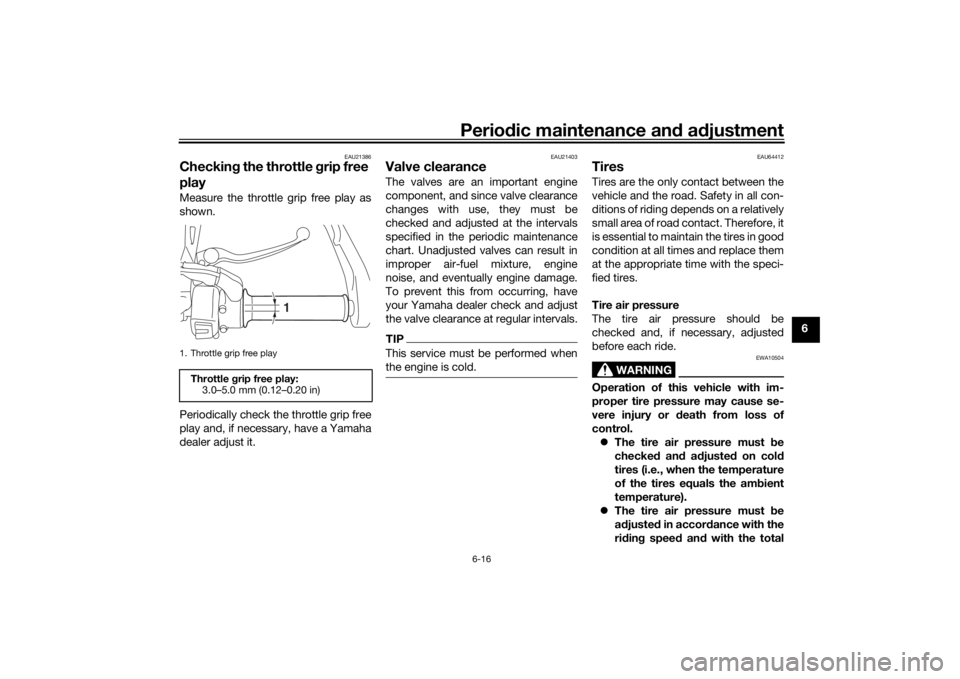
Periodic maintenance an d a djustment
6-16
6
EAU21386
Checkin g the throttle grip free
playMeasure the throttle grip free play as
shown.
Periodically check the throttle grip free
play and, if necessary, have a Yamaha
dealer adjust it.
EAU21403
Valve clearanceThe valves are an important engine
component, and since valve clearance
changes with use, they must be
checked and adjusted at the intervals
specified in the periodic maintenance
chart. Unadjusted valves can result in
improper air-fuel mixture, engine
noise, and eventually engine damage.
To prevent this from occurring, have
your Yamaha dealer check and adjust
the valve clearance at regular intervals.TIPThis service must be performed when
the engine is cold.
EAU64412
TiresTires are the only contact between the
vehicle and the road. Safety in all con-
ditions of riding depends on a relatively
small area of road contact. Therefore, it
is essential to maintain the tires in good
condition at all times and replace them
at the appropriate time with the speci-
fied tires.
Tire air pressure
The tire air pressure should be
checked and, if necessary, adjusted
before each ride.
WARNING
EWA10504
Operation of this vehicle with im-
proper tire pressure may cause se-
vere injury or d eath from loss of
control. The tire air pressure must be
checked and a djuste d on col d
tires (i.e., when the temperature
of the tires equals the am bient
temperature).
The tire air pressure must be
a d juste d in accor dance with the
ri din g spee d an d with the total
1. Throttle grip free playThrottle grip free play:
3.0–5.0 mm (0.12–0.20 in)
1
UB1JE1E0.book Page 16 Thursday, October 11, 2018 10:43 AM
Page 105 of 120
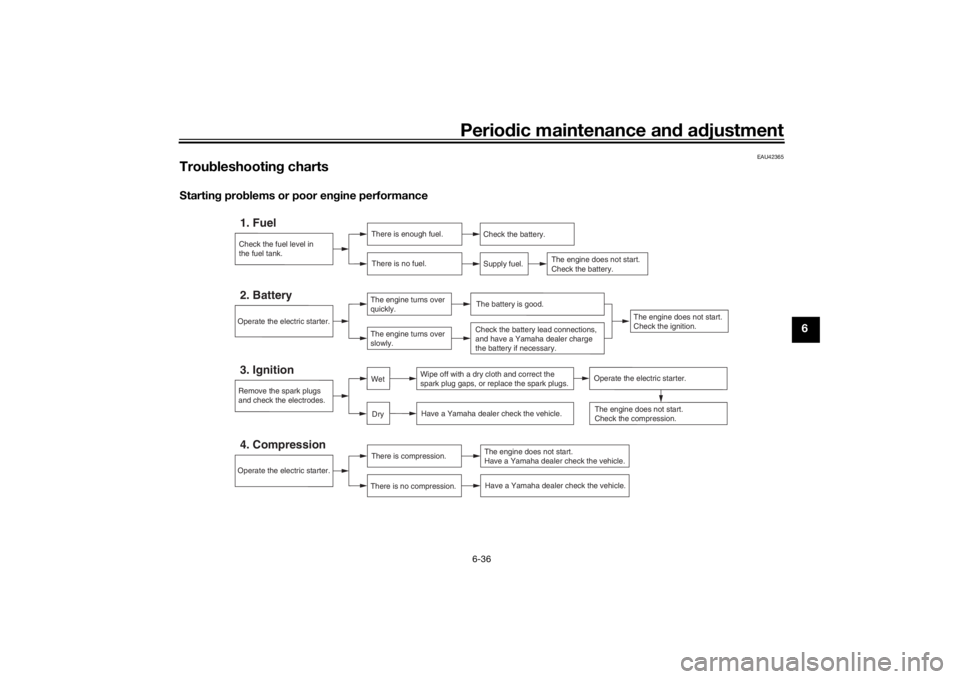
Periodic maintenance an d a djustment
6-36
6
EAU42365
Trou bleshootin g chartsStartin g prob lems or poor en gine performance
Check the fuel level in
the fuel tank.1. Fuel
There is enough fuel.
There is no fuel.
Check the battery.
Supply fuel.
The engine does not start.
Check the battery.
Remove the spark plugs
and check the electrodes.3. Ignition
Wipe off with a dry cloth and correct the
spark plug gaps, or replace the spark plugs.
Have a Yamaha dealer check the vehicle.
Operate the electric starter.4. Compression
There is compression.
There is no compression.
The engine does not start.
Have a Yamaha dealer check the vehicle.Have a Yamaha dealer check the vehicle.
The engine does not start.
Check the compression.
Operate the electric starter.2. Battery
The engine turns over
quickly.
The engine turns over
slowly.
The engine does not start.
Check the ignition.
The battery is good.Check the battery lead connections,
and have a Yamaha dealer charge
the battery if necessary.
DryWet
Operate the electric starter.
UB1JE1E0.book Page 36 Thursday, October 11, 2018 10:43 AM
Page 106 of 120
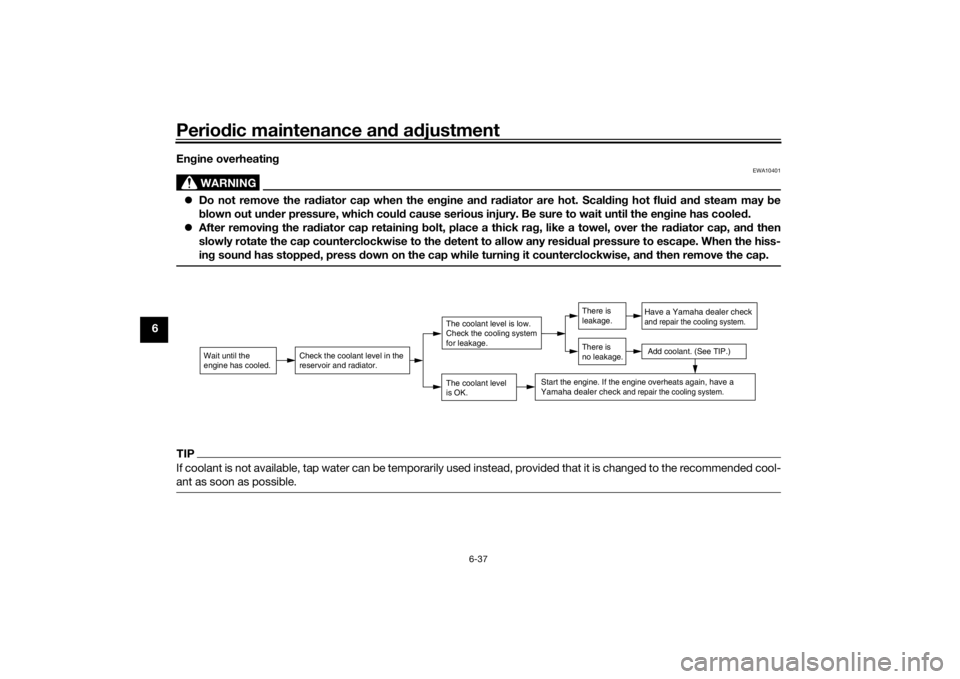
Periodic maintenance an d a djustment
6-37
6 En
gine overheatin g
WARNING
EWA10401
Do not remove the ra diator cap when the en gine an d ra diator are hot. Scal din g hot flui d an d steam may be
b lown out un der pressure, which coul d cause serious injury. Be sure to wait until the en gine has coole d.
After removin g the ra diator cap retainin g b olt, place a thick ra g, like a towel, over the rad iator cap, and then
slowly rotate the cap counterclockwise to the d etent to allow any residual pressure to escape. When the hiss-
in g soun d has stoppe d, press d own on the cap while turnin g it counterclockwise, an d then remove the cap.TIPIf coolant is not available, tap water can be temporarily used instead, provided that it is changed to the recommended cool-
ant as soon as possible.
Wait until the
engine has cooled.
Check the coolant level in the
reservoir and radiator.
The coolant level
is OK.The coolant level is low.
Check the cooling system
for leakage.
Have a Yamaha dealer checkand repair the cooling system.Add coolant. (See TIP.)
Start the engine. If the engine overheats again,
have a
Yamaha dealer check
and repair the cooling system.
There is
leakage.
There is
no leakage.
UB1JE1E0.book Page 37 Thursday, October 11, 2018 10:43 AM
Page 109 of 120
![YAMAHA TRACER 900 GT 2020 Service Manual Motorcycle care and stora ge
7-3
7
will
become slippery, which
coul d cause loss of control.
Thorou ghly clean the surfaces
of these parts before operatin g
the vehicle.
[EWA20650]
5. Treat rubber, YAMAHA TRACER 900 GT 2020 Service Manual Motorcycle care and stora ge
7-3
7
will
become slippery, which
coul d cause loss of control.
Thorou ghly clean the surfaces
of these parts before operatin g
the vehicle.
[EWA20650]
5. Treat rubber,](/img/51/51863/w960_51863-108.png)
Motorcycle care and stora ge
7-3
7
will
become slippery, which
coul d cause loss of control.
Thorou ghly clean the surfaces
of these parts before operatin g
the vehicle.
[EWA20650]
5. Treat rubber, vinyl, and unpainted plastic parts with a suitable care
product.
6. Touch up minor paint damage caused by stones, etc.
7. Wax all painted surfaces using a non-abrasive wax or use a detail
spray for motorcycles.
8. When finished cleaning, start the engine and let it idle for several mi-
nutes to help dry any remaining
moisture.
9. If the headlight lens has fogged up, start the engine and turn on
the headlight to help remove the
moisture.
10. Let the vehicle dry completely be- fore storing or covering it.NOTICE
ECA26320
Do not apply wax to ru bber or
unpainte d plastic parts.
Do not use a brasive polishin g
compoun ds as they will wear
away the paint.
Apply sprays an d wax sparin gly.
Wipe off excess afterwar ds.
WARNING
EWA20660
Contaminants left on the brakes or
tires can cause loss of control. Make sure there is no lu bricant
or wax on the brakes or tires.
If necessary, wash the tires with
warm water an d a mil d d eter-
g ent.
If necessary, clean the b rake
d iscs an d pa ds with b rake
cleaner or acetone.
Before ri din g at hi gher spee ds,
test the vehicle’s brakin g per-
formance an d cornerin g b ehav-
ior.
EAU83472
Stora geAlways store the vehicle in a cool, dry
place. If necessary, protect it against
dust with a porous cover. Be sure the
engine and the exhaust system are
cool before covering the vehicle. If the
vehicle often sits for weeks at a time
between uses, the use of a quality fuel
stabilizer is recommended after each
fill-up.NOTICE
ECA21170
Storin g the vehicle in a poorly
ventilate d room or coverin g it
with a tarp, while it is still wet,
will allow water an d humi dity to
seep in an d cause rust.
To prevent corrosion, avoi d
d amp cellars, stab les (because
of the presence of ammonia)
an d areas where stron g chemi-
cals are stored .Long term stora ge
Before storing the vehicle long term (60
days or more):
UB1JE1E0.book Page 3 Thursday, October 11, 2018 10:43 AM
Page 110 of 120
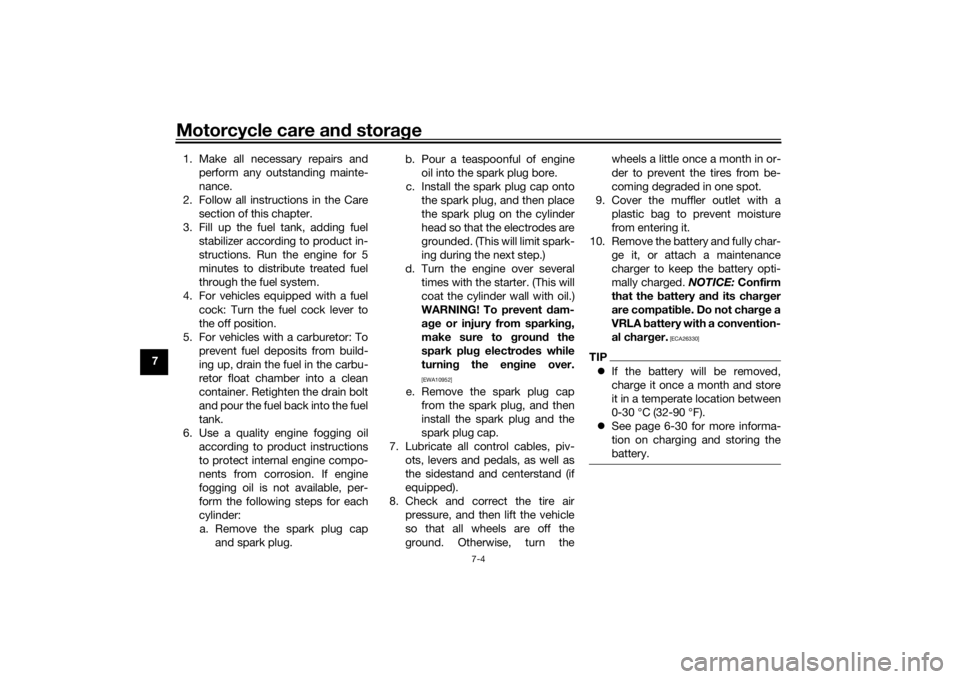
Motorcycle care and stora ge
7-4
7 1. Make all necessary repairs and
perform any outstanding mainte-
nance.
2. Follow all instructions in the Care section of this chapter.
3. Fill up the fuel tank, adding fuel stabilizer according to product in-
structions. Run the engine for 5
minutes to distribute treated fuel
through the fuel system.
4. For vehicles equipped with a fuel cock: Turn the fuel cock lever to
the off position.
5. For vehicles with a carburetor: To prevent fuel deposits from build-
ing up, drain the fuel in the carbu-
retor float chamber into a clean
container. Retighten the drain bolt
and pour the fuel back into the fuel
tank.
6. Use a quality engine fogging oil according to product instructions
to protect internal engine compo-
nents from corrosion. If engine
fogging oil is not available, per-
form the following steps for each
cylinder:a. Remove the spark plug cap and spark plug. b. Pour a teaspoonful of engine
oil into the spark plug bore.
c. Install the spark plug cap onto the spark plug, and then place
the spark plug on the cylinder
head so that the electrodes are
grounded. (This will limit spark-
ing during the next step.)
d. Turn the engine over several times with the starter. (This will
coat the cylinder wall with oil.)
WARNING! To prevent d am-
a g e or injury from sparkin g,
make sure to groun d the
spark plu g electro des while
turnin g the en gine over.
[EWA10952]
e. Remove the spark plug cap
from the spark plug, and then
install the spark plug and the
spark plug cap.
7. Lubricate all control cables, piv- ots, levers and pedals, as well as
the sidestand and centerstand (if
equipped).
8. Check and correct the tire air pressure, and then lift the vehicle
so that all wheels are off the
ground. Otherwise, turn the wheels a little once a month in or-
der to prevent the tires from be-
coming degraded in one spot.
9. Cover the muffler outlet with a plastic bag to prevent moisture
from entering it.
10. Remove the battery and fully char- ge it, or attach a maintenance
charger to keep the battery opti-
mally charged. NOTICE: Confirm
that the battery an d its char ger
are compati ble. Do not char ge a
VRLA battery with a convention-
al char ger.
[ECA26330]
TIP If the battery will be removed,
charge it once a month and store
it in a temperate location between
0-30 °C (32-90 °F).
See page 6-30 for more informa-
tion on charging and storing the
battery.
UB1JE1E0.book Page 4 Thursday, October 11, 2018 10:43 AM
Page 111 of 120
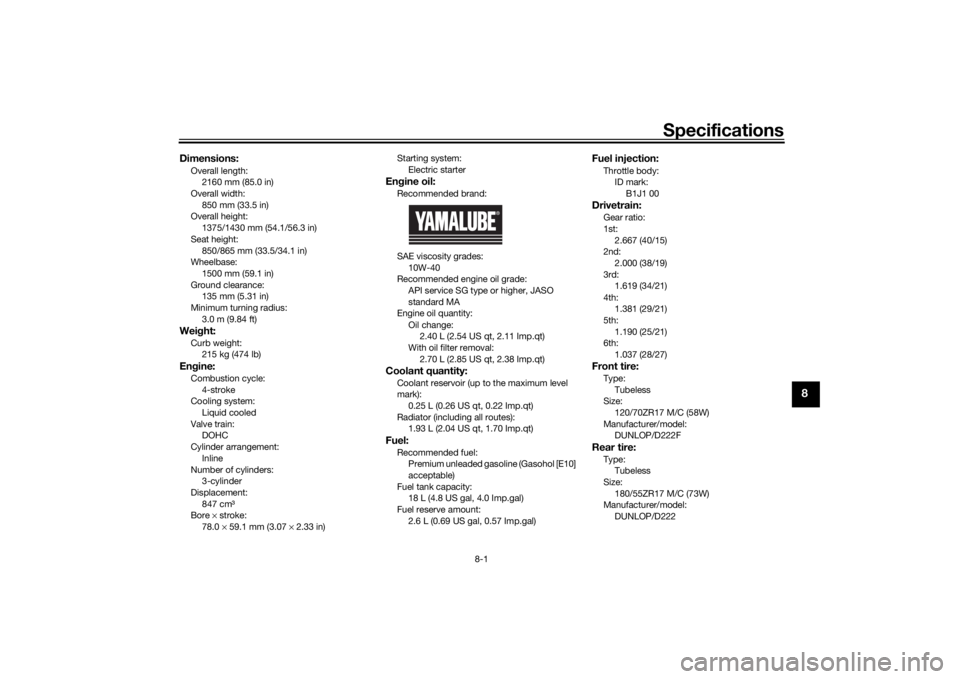
Specifications
8-1
8
Dimensions:Overall length:2160 mm (85.0 in)
Overall width:
850 mm (33.5 in)
Overall height: 1375/1430 mm (54.1/56.3 in)
Seat height: 850/865 mm (33.5/34.1 in)
Wheelbase:
1500 mm (59.1 in)
Ground clearance: 135 mm (5.31 in)
Minimum turning radius: 3.0 m (9.84 ft)Wei ght:Curb weight:
215 kg (474 lb)Engine:Combustion cycle:
4-stroke
Cooling system: Liquid cooled
Valve train: DOHC
Cylinder arrangement:
Inline
Number of cylinders: 3-cylinder
Displacement: 847 cm³
Bore × stroke:
78.0 × 59.1 mm (3.07 × 2.33 in) Starting system:
Electric starter
Engine oil:Recommended brand:
SAE viscosity grades:
10W-40
Recommended engine oil grade:
API service SG type or higher, JASO
standard MA
Engine oil quantity:
Oil change:2.40 L (2.54 US qt, 2.11 Imp.qt)
With oil filter removal:
2.70 L (2.85 US qt, 2.38 Imp.qt)Coolant quantity:Coolant reservoir (up to the maximum level
mark):0.25 L (0.26 US qt, 0.22 Imp.qt)
Radiator (including all routes): 1.93 L (2.04 US qt, 1.70 Imp.qt)Fuel:Recommended fuel:Premium unleaded gasoline (Gasohol [E10]
acceptable)
Fuel tank capacity: 18 L (4.8 US gal, 4.0 Imp.gal)
Fuel reserve amount: 2.6 L (0.69 US gal, 0.57 Imp.gal)
Fuel injection:Throttle body:ID mark:B1J1 00Drivetrain:Gear ratio:
1st: 2.667 (40/15)
2nd:
2.000 (38/19)
3rd: 1.619 (34/21)
4th: 1.381 (29/21)
5th:
1.190 (25/21)
6th: 1.037 (28/27)Front tire:Type:
Tubeless
Size: 120/70ZR17 M/C (58W)
Manufacturer/model: DUNLOP/D222FRear tire:Type: Tubeless
Size: 180/55ZR17 M/C (73W)
Manufacturer/model:
DUNLOP/D222
UB1JE1E0.book Page 1 Thursday, October 11, 2018 10:43 AM
Page 113 of 120
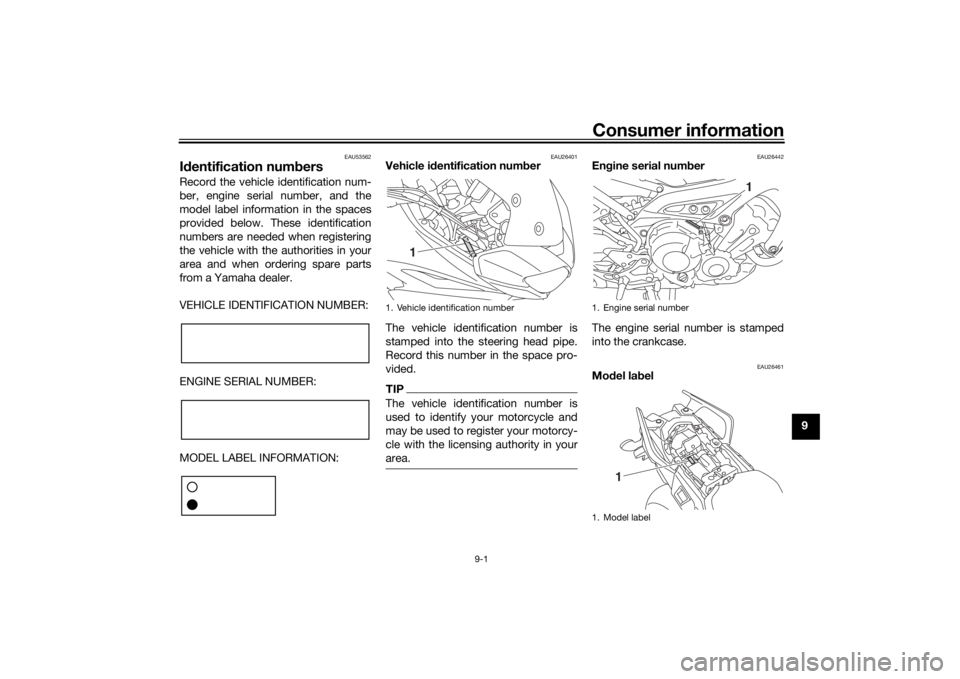
Consumer information
9-1
9
EAU53562
Id entification num bersRecord the vehicle identification num-
ber, engine serial number, and the
model label information in the spaces
provided below. These identification
numbers are needed when registering
the vehicle with the authorities in your
area and when ordering spare parts
from a Yamaha dealer.
VEHICLE IDENTIFICATION NUMBER:
ENGINE SERIAL NUMBER:
MODEL LABEL INFORMATION:
EAU26401
Vehicle i dentification num ber
The vehicle identification number is
stamped into the steering head pipe.
Record this number in the space pro-
vided.TIPThe vehicle identification number is
used to identify your motorcycle and
may be used to register your motorcy-
cle with the licensing authority in your
area.
EAU26442
En gine serial num ber
The engine serial number is stamped
into the crankcase.
EAU26461
Mo del la bel
1. Vehicle identification number
1
1. Engine serial number
1. Model label
1
1
UB1JE1E0.book Page 1 Thursday, October 11, 2018 10:43 AM
Page 114 of 120
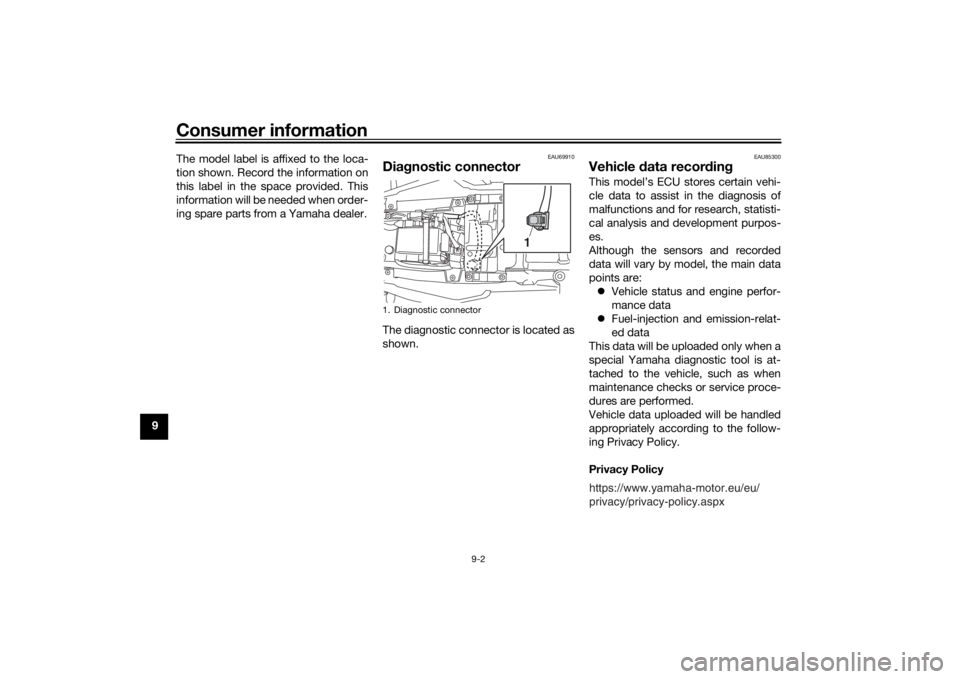
Consumer information
9-2
9The model label is affixed to the loca-
tion shown. Record the information on
this label in the space provided. This
information will be needed when order-
ing spare parts from a Yamaha dealer.
EAU69910
Dia
gnostic connectorThe diagnostic connector is located as
shown.
EAU85300
Vehicle data recor din gThis model’s ECU stores certain vehi-
cle data to assist in the diagnosis of
malfunctions and for research, statisti-
cal analysis and development purpos-
es.
Although the sensors and recorded
data will vary by model, the main data
points are:
Vehicle status and engine perfor-
mance data
Fuel-injection and emission-relat-
ed data
This data will be uploaded only when a
special Yamaha diagnostic tool is at-
tached to the vehicle, such as when
maintenance checks or service proce-
dures are performed.
Vehicle data uploaded will be handled
appropriately according to the follow-
ing Privacy Policy.
Privacy Policy
1. Diagnostic connector
1
https://www.yamaha-motor.eu/eu/
privacy/privacy-policy.aspx
UB1JE1E0.book Page 2 Thursday, October 11, 2018 10:43 AM
Page 116 of 120

10-1
10
IndexAABS ....................................................... 3-27
ABS warning light ................................... 3-6
Air filter element .................................... 6-15
Auxiliary DC connector ......................... 3-44
Auxiliary DC jack ................................... 3-43BBattery .................................................. 6-30
Brake and clutch levers, checking
and lubricating .................................... 6-27
Brake and shift pedals, checking and lubricating ........................................... 6-26
Brake fluid, changing ............................ 6-23
Brake fluid level, checking .................... 6-21
Brake lever ............................................ 3-26
Brake lever free play, checking............. 6-20
Brake light switches.............................. 6-20
Brake pedal........................................... 3-27CCables, checking and lubricating ......... 6-25
Canister................................................. 6-11
Care ........................................................ 7-1
Catalytic converter ................................ 3-33
Centerstand and sidestand, checking and lubricating .................................... 6-27
Clutch lever ........................................... 3-25
Clutch lever free play, adjusting ........... 6-19
Coolant ................................................. 6-14
Cruise control indicator lights ................. 3-6
Cruise control switches .......................... 3-4
Cruise control system ............................. 3-8DData recording, vehicle ........................... 9-2
Diagnostic connector.............................. 9-2 Dimmer/Pass switch .............................. 3-4
Display, main screen ............................ 3-11
Display, menu screen ........................... 3-15
D-mode (drive mode) ........................... 3-25
Drive chain, cleaning and lubricating ... 6-25
Drive chain slack .................................. 6-23
Drive mode switch.................................. 3-4
EEngine break-in ...................................... 5-4
Engine idling speed, checking ............. 6-15
Engine oil .............................................. 6-11
Engine oil and Coolant warning light ...... 3-7
Engine serial number .............................. 9-1
Engine trouble warning light ................... 3-6FFront and rear brake pads, checking ... 6-21
Front fork, adjusting ............................. 3-39
Front fork, checking ............................. 6-28
Fuel ....................................................... 3-31
Fuel consumption, tips for reducing ...... 5-4
Fuel tank cap ........................................ 3-30
Fuel tank overflow hose ....................... 3-33
Fuses, replacing ................................... 6-31HHandlebar position, adjusting .............. 3-39
Handlebar switches ................................ 3-3
Hazard switch......................................... 3-4
Headlight beams, adjusting.................. 3-38
Helmet holder ....................................... 3-37
High beam indicator light ....................... 3-6
Horn switch ............................................ 3-4IIdentification numbers ............................ 9-1
Ignition circuit cut-off system ............... 3-45Immobilizer system .................................3-1
Immobilizer system indi
cator light ..........3-7
Indicator lights and warning lights ..........3-5
LLicense plate light bulb, replacing ........6-34MMain switch/steering lock .......................3-2
Maintenance and lubrication, periodic....6-5
Maintenance, emission control system ..................................................6-3
Matte color, caution ................................7-1
Model label .............................................9-1NNeutral indicator light ..............................3-6PPanel, removing and installing ................6-9
Parking ....................................................5-5
Part locations ..........................................2-1QQuick shift system ................................3-26RRider seat height, adjusting ..................3-35SSafety information ...................................1-1
Seats .....................................................3-34
Shift indicator light ..................................3-7
Shifting ....................................................5-2
Shift pedal .............................................3-26
Shock absorber assembly, adjusting ....3-41
Sidestand ..............................................3-44
Spark plugs, checking ..........................6-10
Specifications .........................................8-1
Starting the engine ..................................5-1
Steering, checking ................................6-29
UB1JE1E0.book Page 1 Thursday, October 11, 2018 10:43 AM